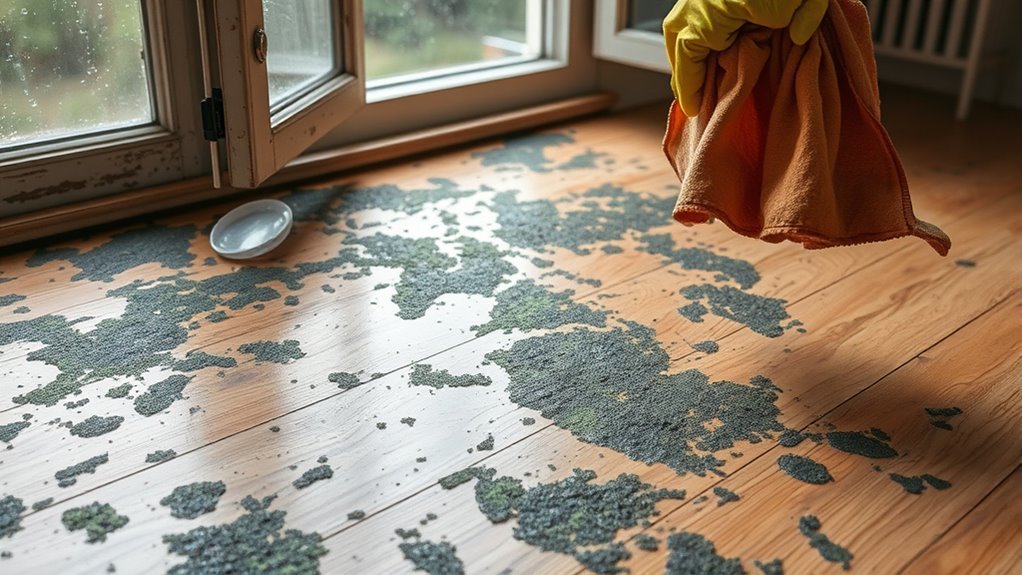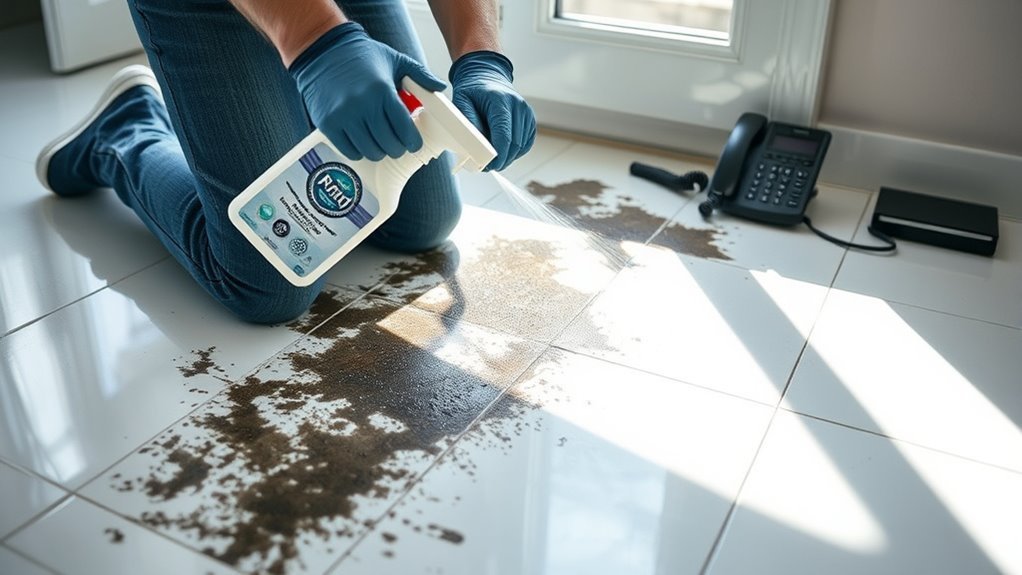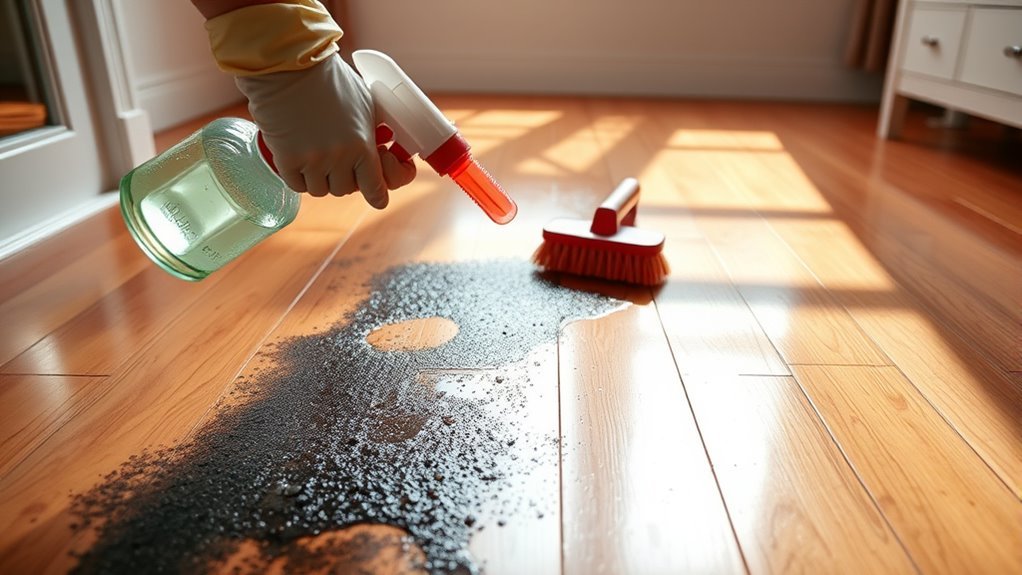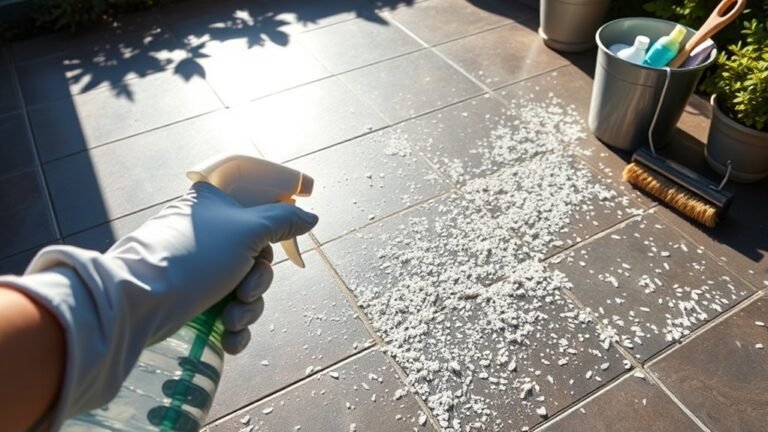How to Clean Mold Floors
To clean mold from floors, first identify and fix moisture sources like leaks or high humidity. Wear gloves, goggles, and a mask before applying a mold cleaner, diluted bleach, or vinegar solution to the affected areas. Scrub thoroughly with a stiff brush, rinse well, and dry completely using fans or dehumidifiers. Maintain humidity below 50% to prevent future growth. For persistent or widespread mold, professional assistance may be necessary. You can explore detailed steps to guarantee effective removal and prevention.
Identifying the Source of Mold

Where is the mold on your floor coming from? Identifying the source is critical to effective remediation. Mold types vary, but all require moisture to thrive. Common moisture sources include leaks, condensation, high humidity, or poor ventilation. You’ll want to inspect plumbing fixtures, window seals, and any cracks in the flooring that allow water intrusion. Different mold types may indicate specific moisture problems; for example, black mold often signals prolonged dampness, while white mold might suggest surface moisture accumulation. Pinpointing these moisture sources lets you address the root cause, preventing recurrent growth. By understanding the interaction between mold types and their moisture environments, you regain control over your living space, ensuring a healthier, mold-free floor.
Preparing Your Cleaning Materials
To effectively clean mold from your floors, you’ll need to gather a specific set of materials designed for mold remediation. Start with essential cleaning supplies such as a stiff-bristled brush, a mop, and buckets. Choose a mold-specific cleaner or prepare a solution like diluted bleach or white vinegar, ensuring it’s suitable for your floor type. Equally important is safety equipment: wear gloves, goggles, and a mask rated for mold spores to protect your respiratory system and skin. Additionally, consider disposable coveralls if the mold infestation is extensive. Ventilation aids like fans or open windows will help dissipate fumes during cleaning. Having these materials ready allows you to work efficiently and safely, giving you the freedom to restore your floors without compromising your health.
Step-by-Step Mold Removal Process

Although mold removal can seem intimidating, following a systematic approach guarantees thorough cleaning and prevents recurrence. First, identify the mold types present, as some require specialized cleaning solutions. Put on protective gear to avoid exposure. Begin by ventilating the area. Next, apply a suitable cleaning solution—such as a diluted bleach or commercial mold remover—directly to the affected floor surfaces. Allow it to sit for 10-15 minutes to penetrate mold colonies effectively. Scrub the floor with a stiff brush to dislodge mold from porous materials. After scrubbing, rinse thoroughly with clean water and dry the area completely using fans or dehumidifiers. Dispose of any contaminated materials properly. By adhering to these precise steps, you guarantee effective mold eradication while maintaining safety and freedom from harmful residues.
Preventing Future Mold Growth
Since mold thrives in damp and poorly ventilated environments, preventing its future growth requires controlling moisture levels and improving airflow. You should maintain consistent humidity control, ideally between 30-50%, using dehumidifiers or ventilation systems to reduce excess moisture. Proper ventilation in rooms with floors prone to mold will inhibit spore settlement and growth. Applying mold resistant paints to floor surfaces or baseboards adds a protective barrier, limiting mold colonization. Additionally, promptly addressing leaks and ensuring floors dry thoroughly after cleaning or spills reduces mold-friendly conditions. Regularly inspecting vulnerable areas helps you identify moisture issues early, allowing swift remediation. By integrating these technical strategies, you gain effective control over your environment, securing freedom from recurring mold problems on your floors.
When to Call a Professional

If mold growth on your floors persists despite thorough cleaning and preventive measures, it’s vital to contemplate calling a professional. Mold inspection by certified experts can accurately assess the extent and type of mold, which is fundamental for effective remediation. Consider professional services if you encounter:
Persistent mold on floors warrants professional inspection to ensure accurate assessment and effective remediation.
- Extensive mold coverage exceeding 10 square feet.
- Recurring mold despite repeated cleaning efforts.
- Mold presence accompanied by water damage or structural issues.
- Health symptoms triggered by mold exposure.
These factors indicate that DIY methods may be insufficient, and specialized equipment or treatments are required. Professionals guarantee safe removal and prevent cross-contamination, protecting both your home and health. Don’t hesitate to leverage expert mold inspection and professional services to regain control and maintain freedom from mold-related risks.
Frequently Asked Questions
Can Mold on Floors Cause Health Problems?
Yes, mold on floors can cause health problems due to mold exposure. When you come into contact with mold spores, you might experience health effects like respiratory issues, allergic reactions, or irritation of the eyes, skin, and throat. People with weakened immune systems or pre-existing conditions are especially vulnerable. It’s important to address mold promptly to protect your health and maintain a safe environment, ensuring you’re not unnecessarily exposed to these risks.
Is Bleach Safe for All Floor Types?
Bleach isn’t safe for all floor materials because it can damage surfaces like hardwood, laminate, or vinyl. You’ll want to check your floor’s specifications before using it. Instead, consider bleach alternatives like hydrogen peroxide or vinegar solutions, which are gentler but still effective against mold. Always test a small, inconspicuous area first to verify no discoloration or damage occurs. This way, you maintain your floor’s integrity while keeping it mold-free.
How Long Does Mold Take to Grow on Floors?
Think of mold growth as a silent invader that can take root within 24 to 48 hours on damp floors. You’ll want to act fast because once those spores settle, they multiply rapidly, especially in humid conditions. To keep your space free and clear, focus on prevention tips like controlling moisture, ensuring proper ventilation, and promptly drying wet areas. Staying proactive helps you maintain your freedom from mold’s clingy grasp.
Can Household Vinegar Effectively Kill Mold?
You’ll find vinegar effectiveness against mold is notable due to its acetic acid content, which disrupts mold cell growth. While it’s a natural alternative to harsh chemicals, vinegar may not eliminate all mold types or deeply embedded spores. For freedom from synthetic cleaners, it’s a practical first step, but combining vinegar with thorough drying and ventilation guarantees better results. Always test on surfaces to prevent damage before full application.
What Personal Protective Equipment Should I Wear?
Think of protective gloves and safety goggles as your armor in a battle against invisible invaders. Just like a knight wouldn’t charge without a shield, you shouldn’t clean mold without these essentials. Protective gloves prevent skin contact with harmful spores and cleaning agents, while safety goggles shield your eyes from irritants. Wearing them guarantees your freedom to work safely and confidently, minimizing health risks during mold removal.






